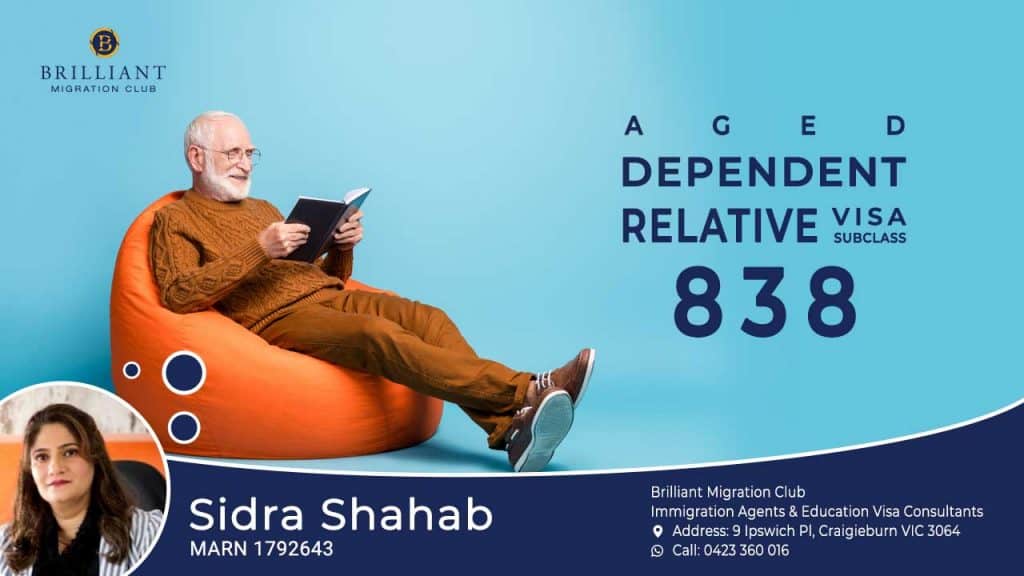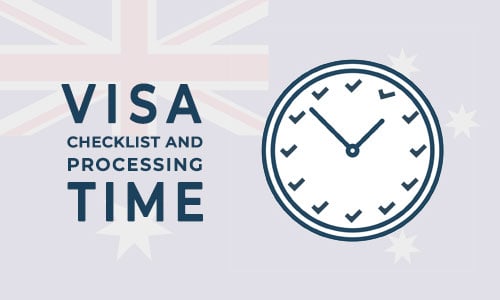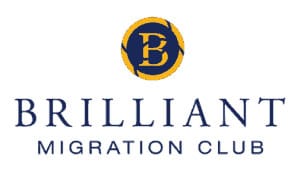
Aged Dependent Relative Visa Subclass 838
The aged dependent relative visa Subclass 838 onshore visa, just like Subclass 114, allows an eligible applicant to reside permanently in Australia, subject to complete dependence on an eligible sponsor who should be a close relative of the applicant.
However, contrary to Subclass 114 where the applicant can apply from outside Australia, He/she must be present in Australia at the time of application for a Subclass 838 onshore visa. After qualifying for permanent residence, the applicant can also apply for Australian citizenship after a certain duration.
As only a handful of applications of the particular subclass are processed each year, the visa issuance can take from one to few years, depending upon the number of applicants and transparency of the documents. Which means one must show a lot of patience when applying.
If you or one of your loved ones is going to apply for the Subclass 838 Visa, it’s crucial to know about the various conditions, documents, and requirements of the specified Subclass to make your long waiting fruitful.
This is because even the slightest inaccuracy or misunderstanding of the process can lead to rejection. To make sure nothing like this happens, let’s go through a brief overview of the complete process and its major requirements.
We hope clear your mind at the end of this helpful article:
Primary Conditions for Subclass 838 Onshore Visa
The Subclass 838 onshore visa only stays valid if the applicant is:
- Living inside Australia at the time of application lodgement.
- Sponsored by an eligible sponsor/relative
- Free of any debts from the Australian government
- Not subject to visa cancellation or rejection amidst the stay in Australia
- Devoid of any visa conditions during the stay

Eligibility criteria for Aged Dependent Relative Visa Subclass 838
Following is the eligibility criteria for both applicant and sponsor:
Eligible applicant
To stay eligible for a Subclass 838 onshore visa, the applicant must:
- Be a close member of the sponsor.
- Not be married or in a de-facto relationship.
- Be completely dependent on the sponsor for basic requirements.
- Have no other source of income/support.
- Be of valid age limit (65 years for men and 60 years for women)
- Meet the health requirements
- Meet character requirements
- Sign the Australian government statement
Eligible Sponsor
To stay eligible for sponsoring a relative on Subclass 838 visa, the sponsor must:
- Be a permanent Australian resident or settled citizen
- Be older than 18 years
- Reside in Australia (usually)
- Or someone who meets all the aforementioned qualifications and is the cohabiting partner of the sponsor
Valid Relationships
Following are the relationships that fall under MoHA
- Parent
- SIbling
- Child
- Grandparent
- Grandchild
- Aunt
- Uncle
- Niece/Nephew
Note: Step equivalents of the aforementioned relatives are also eligible to sponsor the applicant.

Evidence Required for Subclass 838
As age-dependent Visas like Subclass 838 and Subclass 114 are meant for sponsoring very close relatives, solid evidence will be required from both sponsor and applicant to prove the relationship. Some of the documents that can be used for the purpose include:
- Marriage certificate
- Birth certificate
- Adoption certificate
- Death certificate (if the applicant is widowed)
- Family Status certificates
The above-given documents will automatically prove the nature of the relation between the applicant and the sponsor. However, if the applicant is the sponsor’s uncle or aunt, the applicant and the sponsor both will be required to show their birth certificates that confirm the relationship between the sponsor’s parents and the applicant.
Alternative Documents
If the aforementioned documents are lost due to some unfortunate event and cannot be recovered at the moment, the following documents can be used as alternative proof:
- Medical records
- Taxation records
- Health records
- Will/testament/bonds
- Social security records
- Departmental records
- Other documents
As the above-mentioned documents don’t concisely explain the relationship status, the applicant might need at least 2 or 3 of them to prove a valid family link. Moreover, each document should be congruent to the other one.
Additional Proofs required
Apart from providing evidence for MoFU, there are additional proofs that the applicant must provide to keep his/her eligibility status intact. The applicant must prove that:
He/she is not in a marital or de facto relationship
As the Subclass 838 Onshore visa requires the applicant to be completely dependant on the sponsor, he/she must be single. The following documents can be used as evidence subject to different circumstances:
- Death certificate of the spouse
- Divorce certificate
- Separation documents
- Family status certificates
If these documents aren’t available due to some reason, the following can be used as an alternative:
- Departmental records
- Taxation records
- Social security records
He/she is fully dependant
This is one of the most crucial factors that play a pivotal role in visa issuance. Here, the applicant must provide solid evidence that he/she has been dependant on the sponsor for a reasonable amount of time, and will continue to do so due to a certain inability or other reasons.
The judgment will be based on the following factors:
- Provision of reasons for financial dependency, e.g inability
- Previous support duration
- The extent of support required
- Documented evidence of previous transactions from sponsor to the applicant
Extent of dependability
Just like the Subclass 114 offshore visa, the Subclass 848 onshore also requires the applicant to have been dependent on the sponsor for a reasonable time and must back it up with solid evidence that supports the claim. There are three major sub-parts of dependency that play a major role in the acceptance or rejection of a visa.
Those include:
Reliance extent
Reliance extent means the “level of dependability” of the applicant on the sponsor. For someone to fully pass the dependability criteria, he/she must:
- Not be able to afford the basic living cost
- Prove that the income provided isn’t sufficient to fulfill basic financial needs
- Have a majority of income (at least 60%) coming from the sponsor
Dependency Period
The applicant must show that he\she has been dependant on the sponsor for at least 3 years prior to application lodgement. However, this condition can be softened subject to certain conditions. For example, if the applicant’s spouse has been receiving money from the sponsor and now he or she’s passed away, the applicant can provide previous transaction history along with the death certificate of the deceased partner.
Continued Dependence
The applicant must be dependent on the sponsor at the time of application lodgement and at the time of visa issuance. The concerned department can ask for evidence in certain cases. So it’s better to keep them ready.
When is a sponsor considered settled?
The sponsor is considered a settled Australian citizen if he/she:
- Have had a reasonable period of residence in the country.
- Has been at least for 2 years in Australia with less than 4 months abroad.
- Has evidence of settlement (if spent more than 4 months outside Australia)
Evidence required from the sponsor.
The following pieces of evidence can be asked for if the sponsor has remained absent for more than 4-months within 2-years duration prior to lodgement of application:
1. If the sponsor is in Australia at the time of application
- Evidence of sponsor or sponsor’s partner’s employment.
- Documented evidence of house ownership or lease agreement.
- Evidence of sponsor’s children attending school.
- Bank statement.
- Evidence of the reason for prolonged absence from the country.
- Evidence of sponsor’s children being Australian citizens.
2. If the sponsor is outside Australia at the time of application
- Evidence of the sponsor being posted by a registered Australian company.
- Evidence from the sponsor’s employer for extended employment outside the country on an ongoing basis. In the meantime, the wages should be paid by the Australian registered company or organization, with the taxes provided to the Australian government
- Ownership of a residence that proves that sponsor intends to reside in Australia
- If the sponsor is not employed, the aforementioned documents of the sponsor’s partner must be provided
- Evidence of the children attending school, if any
- Evidence of advance arrangements being made to provide education to the children, if they are preschool-aged
- Bank statements
- Evidence of sponsor’s children being Australian citizens

Visa Checklist for Subclass 838
To avoid visa rejection, the applicant must follow the below-given checklist. This will ensure that the visa is processed in due time, with increased chances of application acceptance.
- While applying, the applicant should check his/her passport and seek help in case of confusion.
- Make sure to collect all the required documents and proofs that need to be submitted.
- Attach all the documents to your application and submit them to the concerned authorities
- The applicant should be in Australia at the time of application lodgement, as the term “onshore” implies.
- A confirmation email will be sent from the authority when the application is received.
Processing time
The age-dependent relative subclass 838 onshore visas are given on a first come first serve basis. Moreover, only a few of these visas are processed, so it is going to take a year (or a few) for the visas to be processed. The waiting period can be even more if:
- The forms are filled incorrectly.
- The information provided is not sufficient; more documents can be requested by the authorities.
- The processing fees aren’t cleared on time.
For further information about the Age-Dependent Subclass 114 visa, kindly visit the official website of the Australian Department of Home Affairs. If you are an applicant, talk to your concerned agent before, and during the application process for a smooth and less stressful experience.
